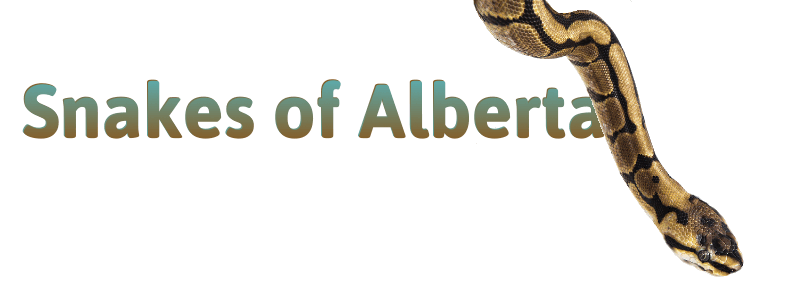 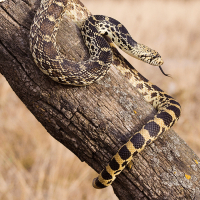 Bull Snake
Bull SnakeThe Bull snake is the largest snake in Alberta, found in the drier parts of the province in the south, in desert or short-grass prairie, and can each 2 metres in length. Bull snakes are diurnal, preferring the warmest part of the day. When harassed, a Bull snake may hiss, strike, or vibrate its tail, but it is not a venomous snake; it kills by constriction. It preys on small mammals, mostly rodents, as well as birds and their eggs. Bull snakes have enlarged scales on the nose for digging, and they are also excellent climbers; they are often found in trees looking for bird nests. Bull snakes are oviparous, meaning that they lay eggs. They can lay anywhere between 2 and 24 eggs, twice during the summer. Young snakes emerge in the late summer or early fall. 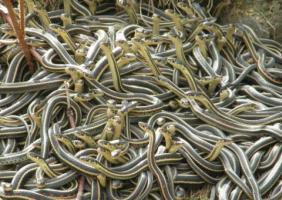 Many snakes overwinter in a burrow, rock pile, dead tree, or some other covered location. This den, or hibernaculum, will keep them safe in winter; snakes brumate, similar to hibernation in mammals, and the below ground space must maintain a consistent temperature above 0°C so the snake(s) do not freeze, and there needs to be a water supply (although snakes don't eat while brumating). Some species of snakes prefer to brumate alone or in small numbers, while other species do so in large groups. In the spring as the outside temperature begins to get warmer, snakes will often emerge from their hibernacula to bask, but remain nearby in case the temperature begins to fall again.
Many snakes overwinter in a burrow, rock pile, dead tree, or some other covered location. This den, or hibernaculum, will keep them safe in winter; snakes brumate, similar to hibernation in mammals, and the below ground space must maintain a consistent temperature above 0°C so the snake(s) do not freeze, and there needs to be a water supply (although snakes don't eat while brumating). Some species of snakes prefer to brumate alone or in small numbers, while other species do so in large groups. In the spring as the outside temperature begins to get warmer, snakes will often emerge from their hibernacula to bask, but remain nearby in case the temperature begins to fall again.
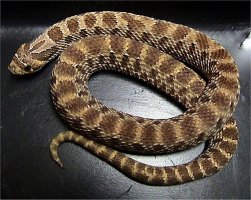 Western Hog-nosed Snake
Western Hog-nosed SnakeWestern hog-nosed snakes can be found in the short and mixed grass prairie of the south-eastern corner of Alberta. They are a small, heavy-bodied snake. The 'hog-nose' in their name refers to the upturned, spade-like snout, which they use to burrow and dig out their primary food source, toads. They are naturally resistant to the toxins produced by toads as defense against predators. They also eat frogs, salamanders, lizards, snakes (particularly garter snakes), birds, small mammals, and bird and reptile eggs. Western hog-nosed snakes are diurnal, and can reach 75 cm in length, with the females typically being larger than the males. They are oviparous (laying eggs, not giving birth to live young), and can lay anywhere from 4 to 23 eggs. In Alberta, eggs are deposited from mid-June to early July. The incubation period is about 60 days. Hog-nosed snakes are famous for their threat displays. They will hiss and flatten themselves to make themselves look larger, and will even exhibit closed-mouth strikes. If the bluff fails to deter the threat, they will fake death, flipping on their backs, gaping the mouth, hanging the tongue out, and salivate. These snakes until fairly recently were considered non-venomous. Though they don't present a risk to humans (there has never been a reported death due to a Hognose bite), recent evidence shows that they are actually rear-fanged, with large, ungrooved teeth, and mildly venomous. They produce the venom in a modified salivary gland, not a venom gland as found in other venomous snakes. Their fangs are not hollow, so they can't inject venom, depending on chewing action to get the venom into wounds caused by the teeth. 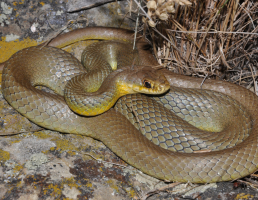 Eastern Yellow-bellied Racer
Eastern Yellow-bellied RacerThe Eastern Yellow-bellied Racer is a slender, fast-moving snake with smooth scales. Adults are plain-colored above (grey, brown, olive or slightly blueish) with white to yellow bellies. They have large eyes with round pupils. These snakes are extremely rare in Alberta; they're found in just one locality in the grasslands of the southeastern portion of the province. Adult racers range in length from 50 cm to 1.5 m in length. They are active, diurnal hunters, with large eyes and excellent vision. They do not constrict their prey to kill it, but instead depend on the strength of their jaws to crush their prey. Young racers primarily eat invertebrates such as grasshoppers, crickets, and caterpillars, while adult racers prefer vertebrate prey, like rodents, frogs, and small reptiles. They tend to hunt in a unique style, with their head held up to give them a better view of potential prey. Garter Snakes 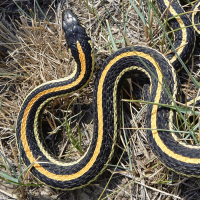 Plains Garter Snake
Plains Garter SnakeThe plains garter snake is a grassland snake with an orange-red to yellow dorsal stripe and dark spots that form a checkered pattern. Its length can be up to a metre. It isn't dangerous to humans, although it may release a foul-smelling musk when provoked. It hunts frogs and other small animals in wetlands and sloughs. In winter it brumates in underground mammal burrows or rock piles, mating in the spring after emerging from sleep. Females can give birth to 5–40 young. 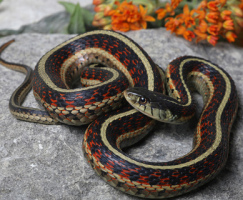 Red-sided Garter Snake
Red-sided Garter SnakeThe red-sided garter snake is a common and widespread snake in Alberta. It's the most likely snake to be found in the Edmonton region. It has very distinctive and beautiful markings: dark olive to black in colour with a pale dorsal stripe, red side blotches and a yellow or green stripe along the top of its back and each side of the body. It usually makes a quick retreat when approached by humans. It can grow to over a meter long, and like most garter snakes, will eat just about anything: small mammals, amphibians, and even invertebrates like slugs and earthworms. This makes them important mid-level predators, helping to manage the populations of these animals within the ecosystem while also being a much needed food source for other predators. They aren’t dangerous to humans, but when provoked may release a terrible smell. Red-sided garter snakes are famous for congregating in large numbers (hundreds to thousands) in their over-wintering sites, and then emerging in great numbers in the spring for a massive mating frenzy before dispersing. They are mature at 2-3 years of age. Mating balls of dozens of males will congregate around a small number of females. The famous Narcisse Snake Dens north of Winnipeg are occupied by red-sided garter snakes, as is the Lake Eden den site near Edmonton. 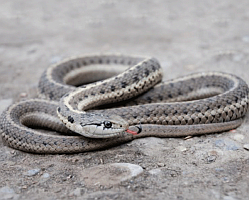 Wandering Garter Snake
Wandering Garter SnakeWandering garter snake adult lengths can range from 40 cm to 100 cm. Their active season is from April to October. Mating occurs when they emerge from their hibernacula in the spring, and young are born live during mid to late summer; 4-21 young may be born in a litter. Wandering gartersnakes consume both invertebrate and vertebrate prey. Slugs, worms, snails, and leeches make up the invertebrate part of their diet, while tadpoles, frogs, small fish, and sometimes mice make up their vertebrate prey. In Alberta these snakes can be found in the southern half of the province, occupying portions of the rocky mountain, foothills, parkland, and grassland regions. A necessary habitat feature for these snakes (and all snakes) is a place to overwinter in. Structures can include abandoned mammal burrows, rock crevices, and caves. Since snakes are ectothermic they cannot regulate their own body temperature, so the hibernaculum must provide shelter below the frost line to provide adequate insulation from the cold winter temperatures. 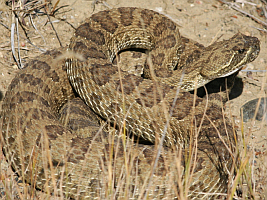 Prairie Rattlesnake
Prairie RattlesnakeThe prairie rattlesnake is the only Alberta snake which is a danger to humans. However, despite being Alberta's only venomous snake, its bite is rarely fatal to humans because most bites are "dry" (meaning no venom is injected), and with prompt medical attention, antivenom can effectively counteract the venom's effects; additionally, their venom is not as potent as some other rattlesnake species. It is a shy reptile that relies on camouflage to avoid detection. It uses its rattle to warn people and other animals of its presence, and will only strike if provoked or surprised. It is mainly crepuscular, although it can be active during the day. The prairie rattlesnake can be found in mixed-grass and short-grass prairie, near river banks, coulees, badlands, and sage-flats in the drier areas of southern Alberta. It can grow to a length of 1.5 metres, and can have a lifespan of 30 years. This snake is very economically significant as a rodent controlling predator, and is protected as a non-game animal; it's illegal to kill, buy, sell, or possess them. The Alberta Wildlife Act also protects their dens. |